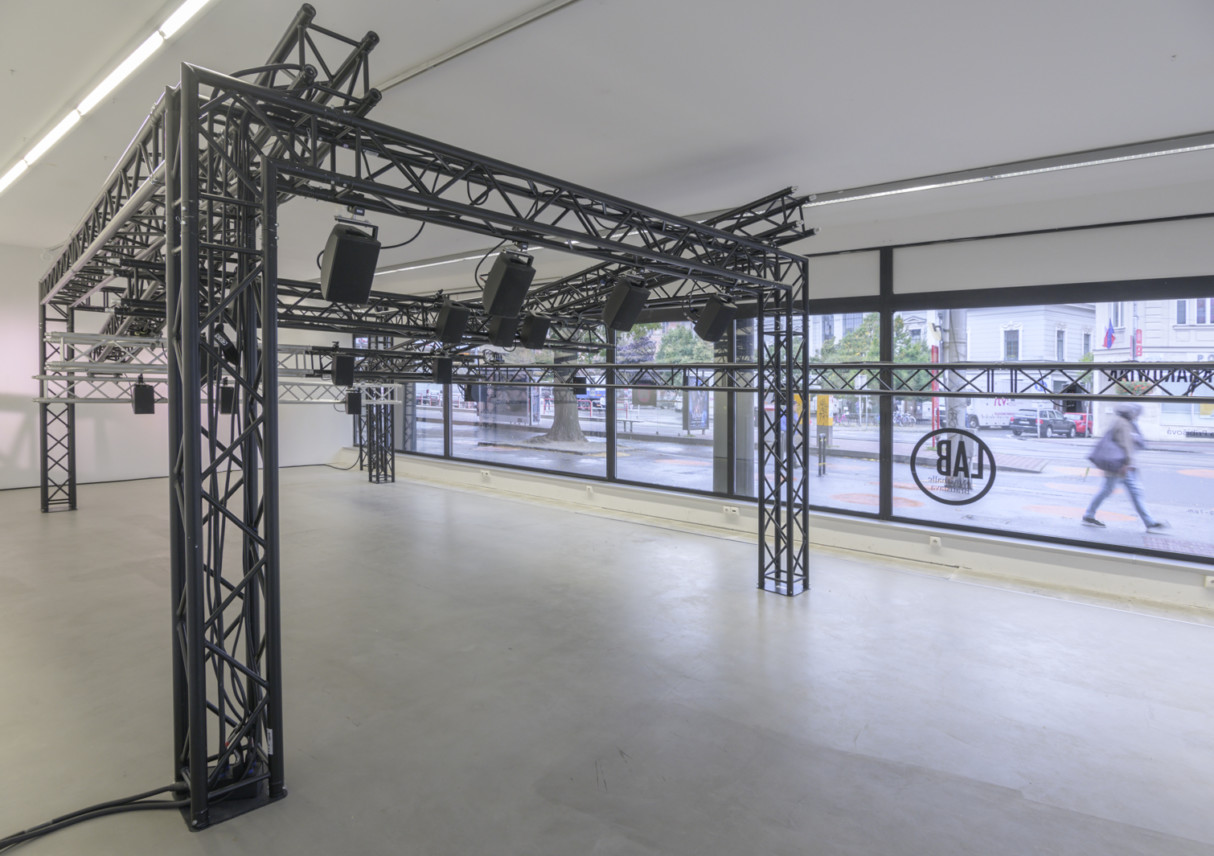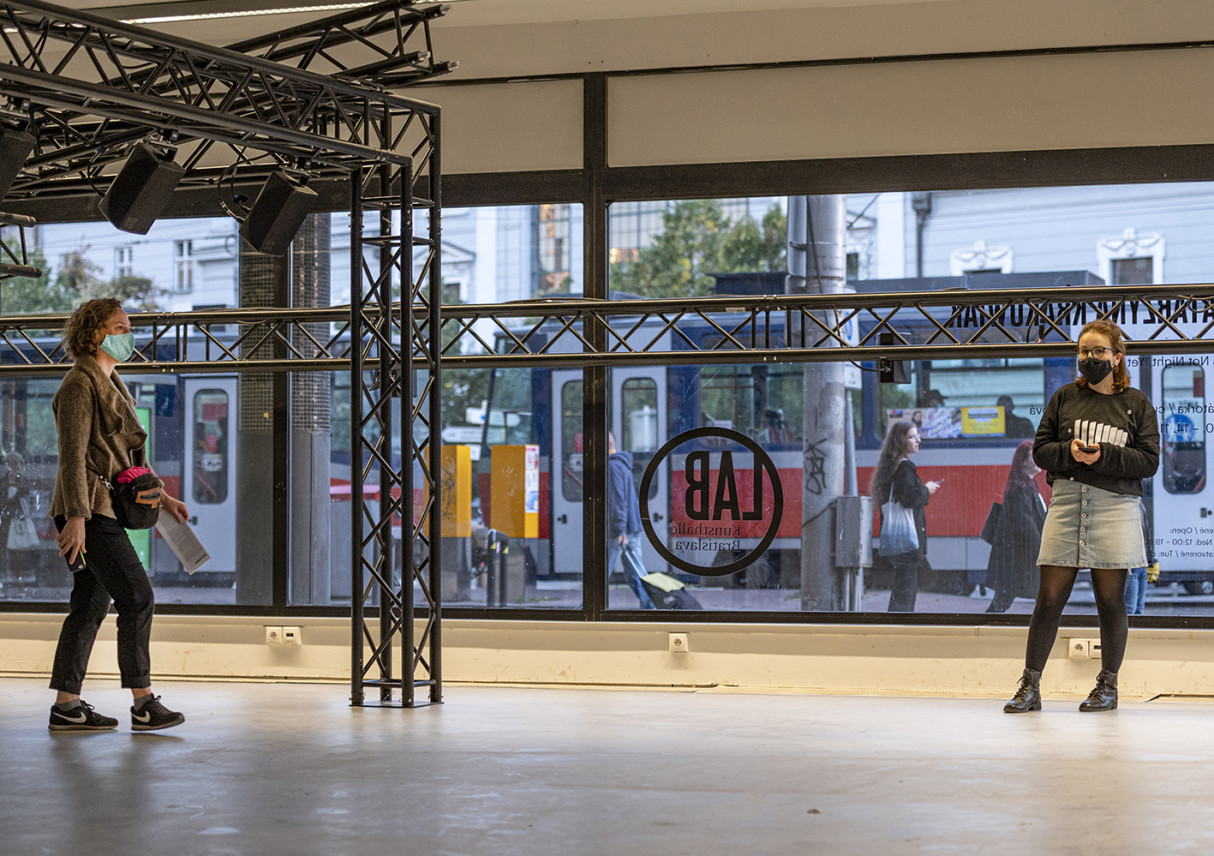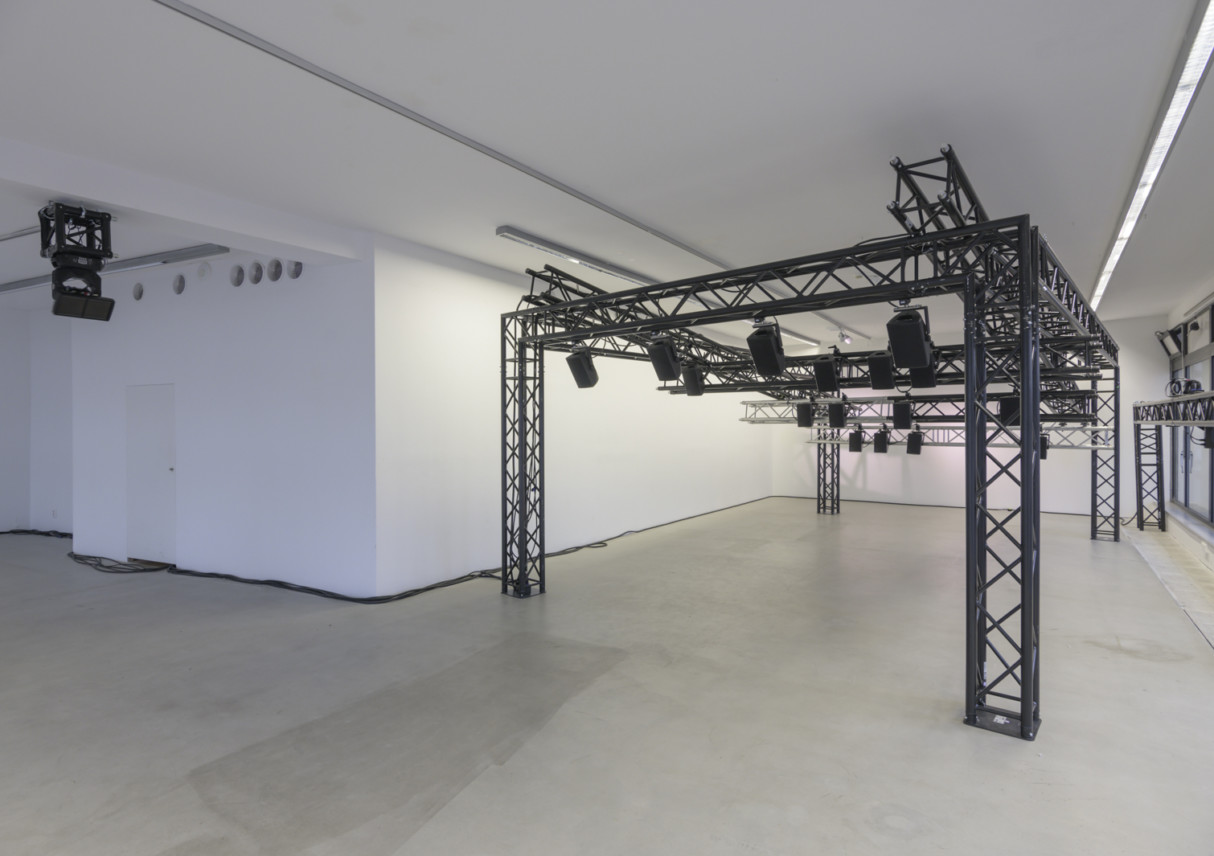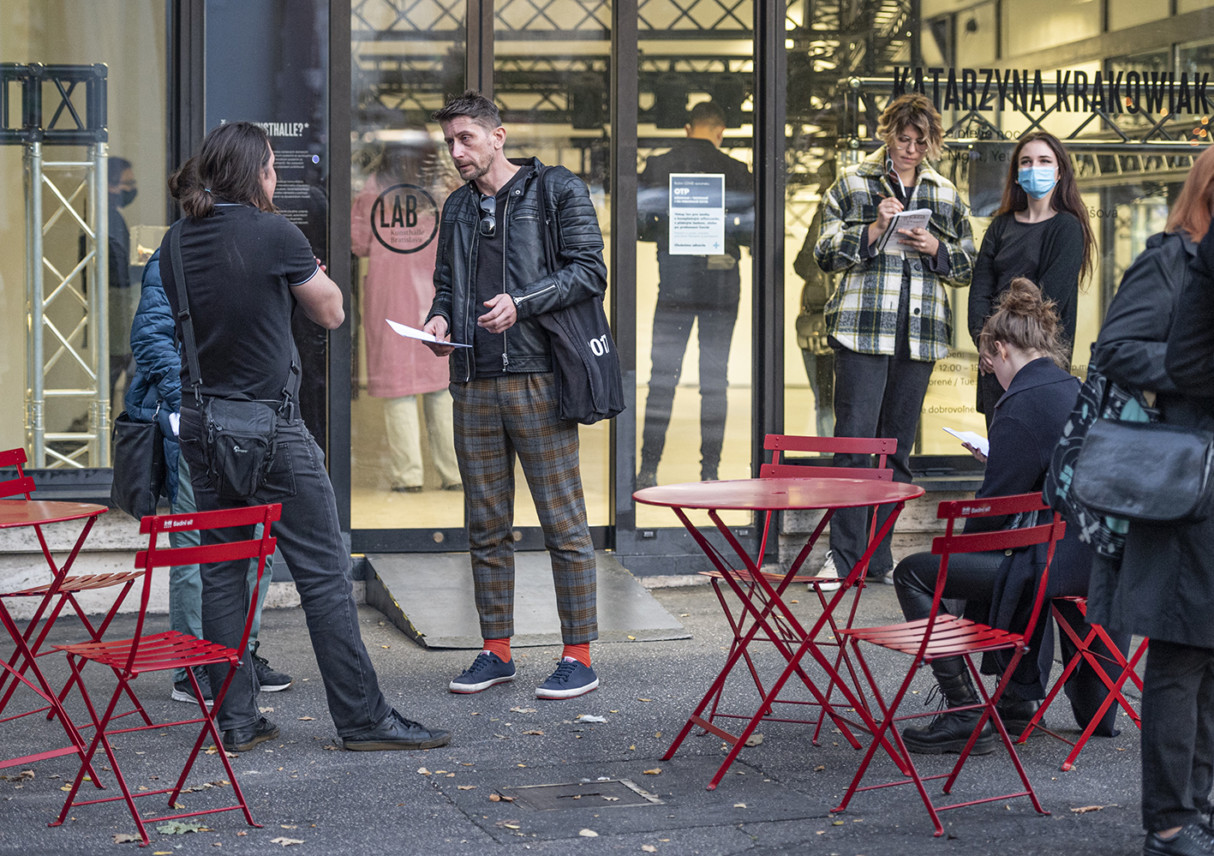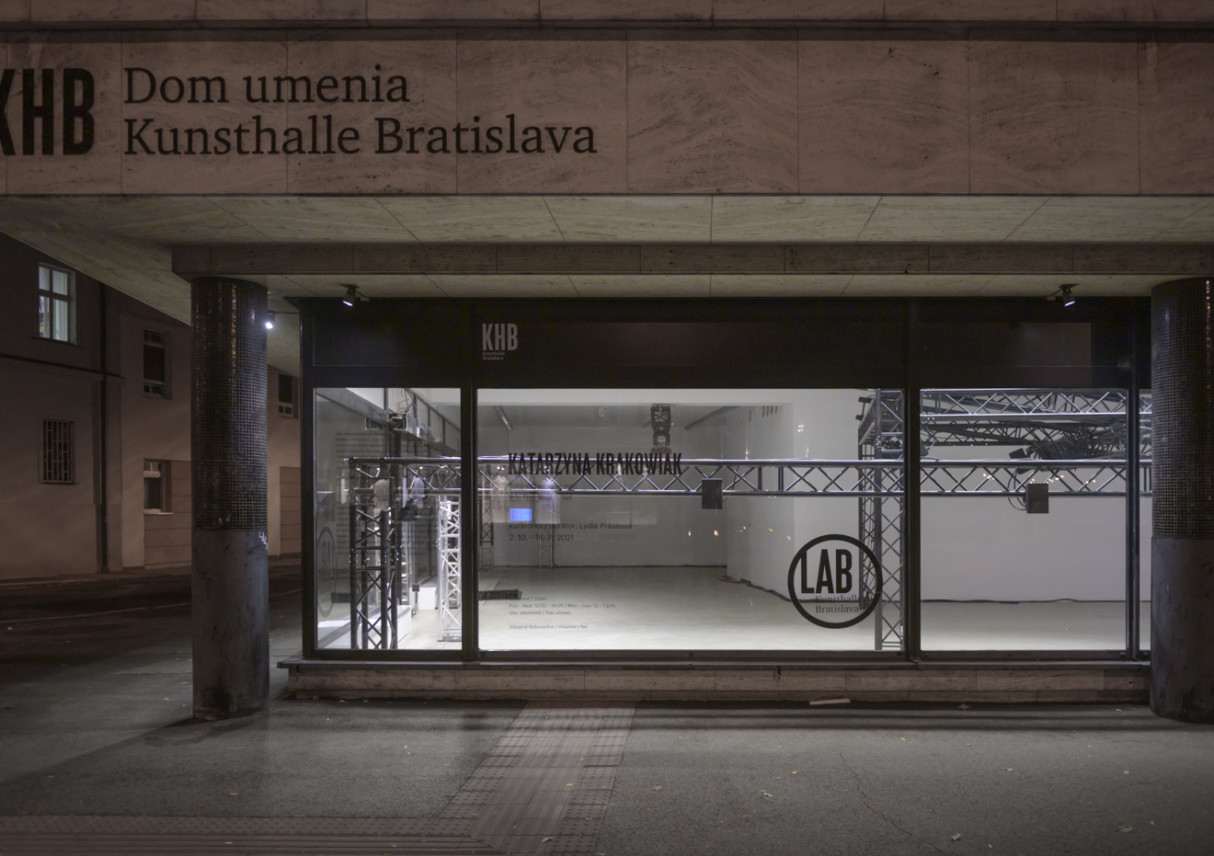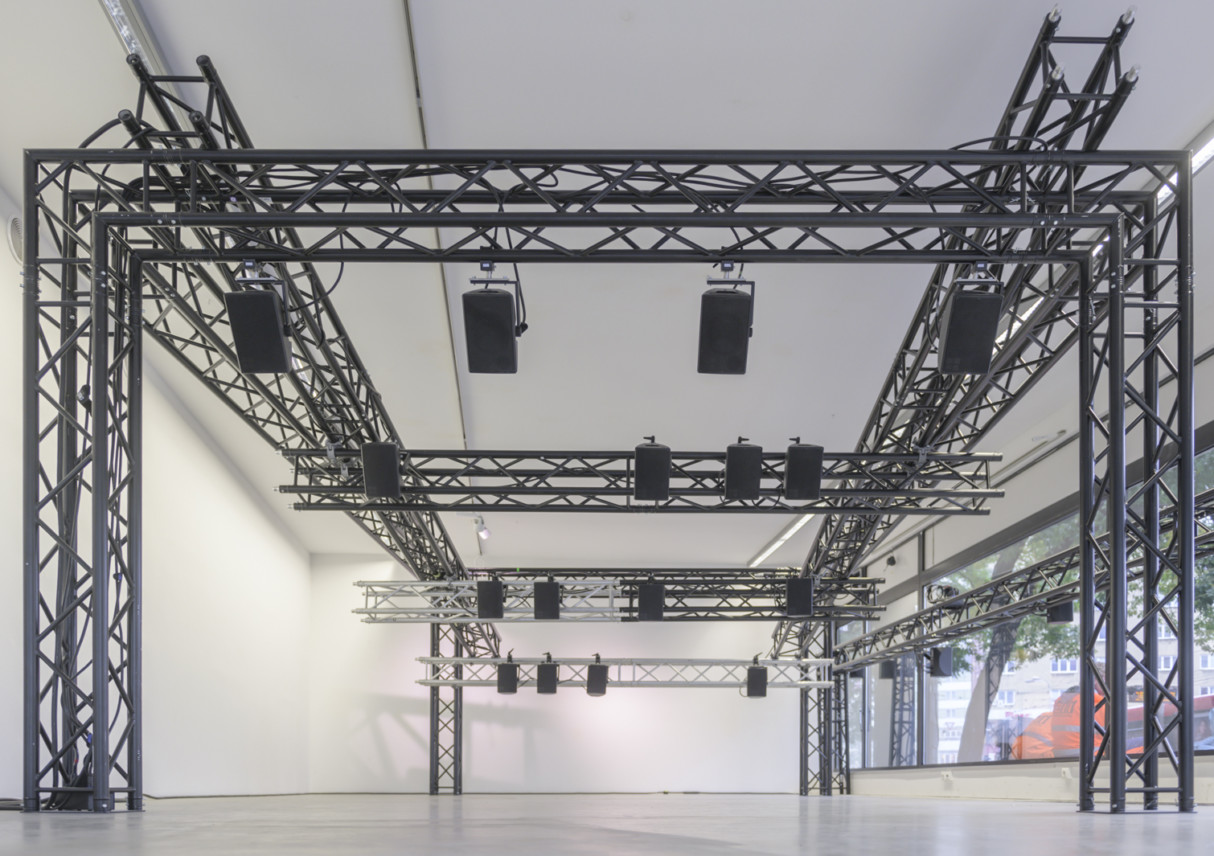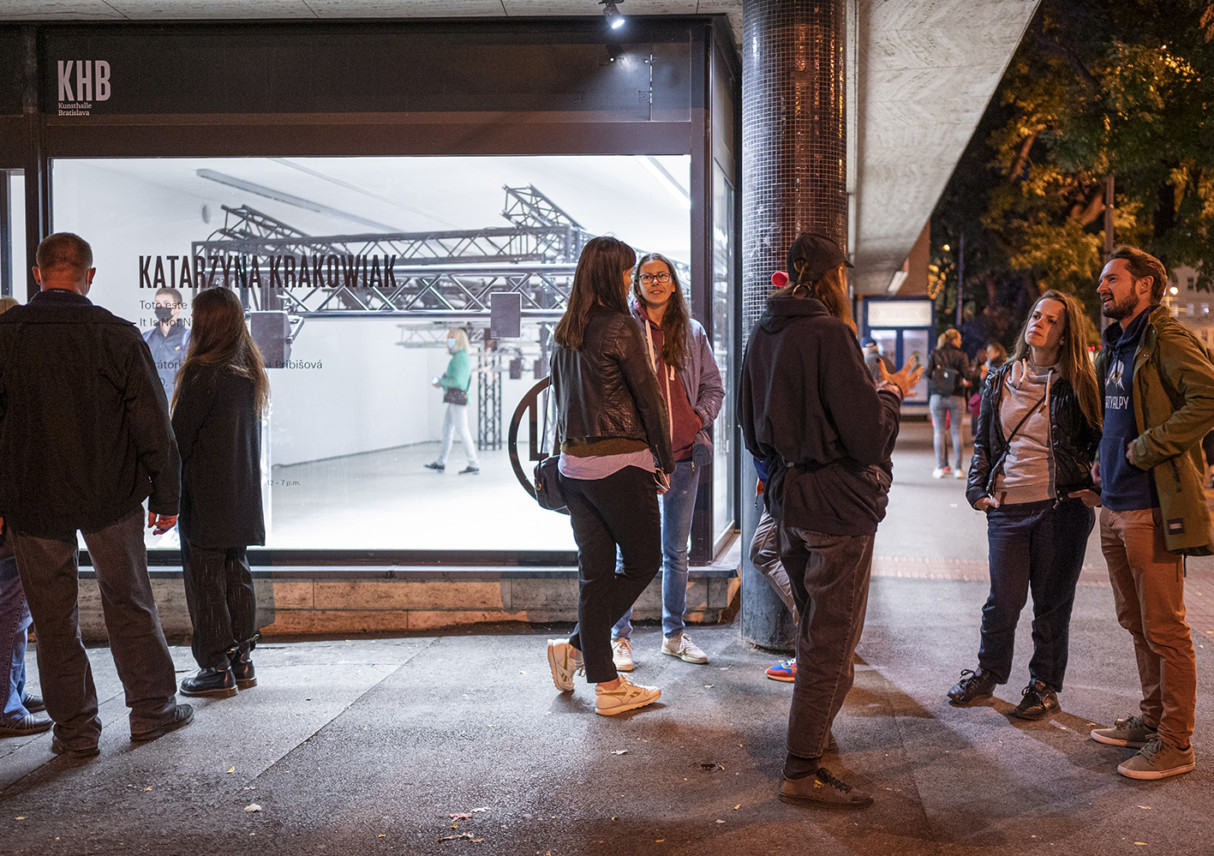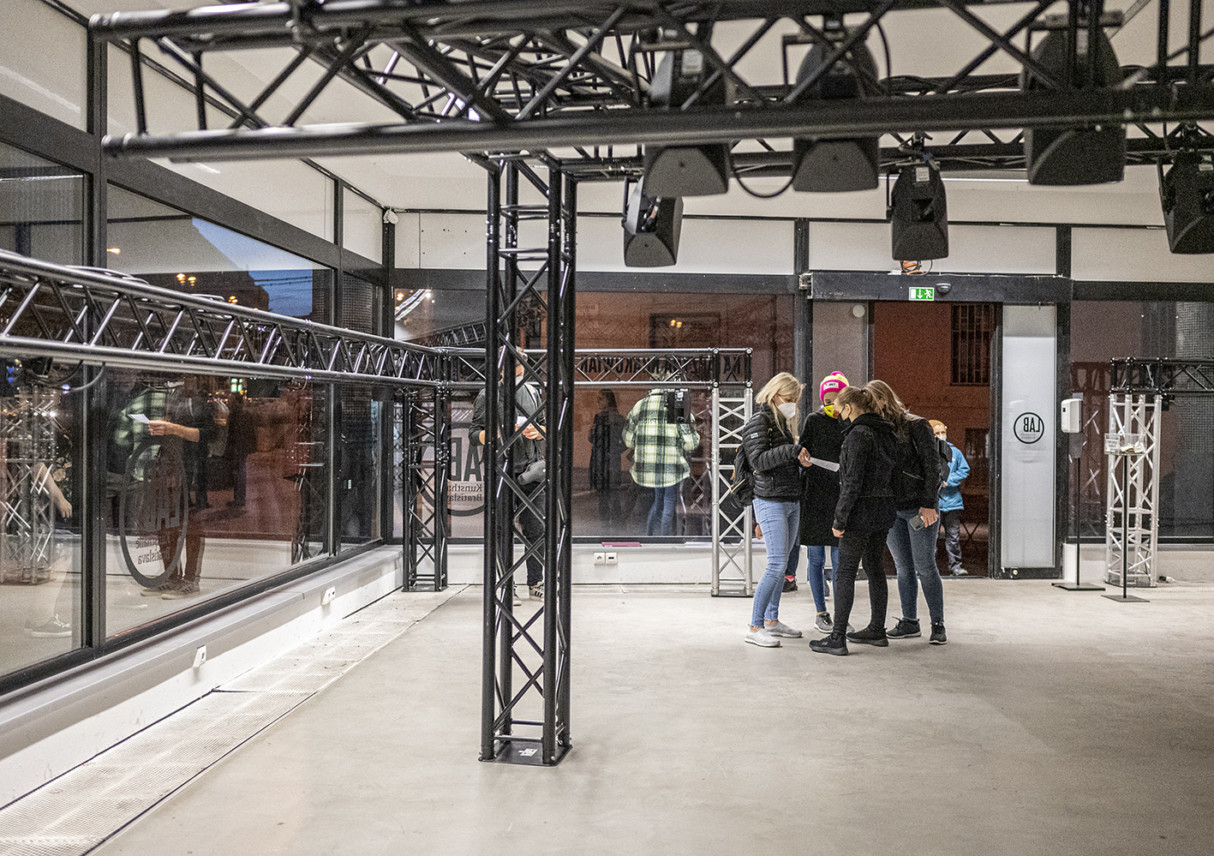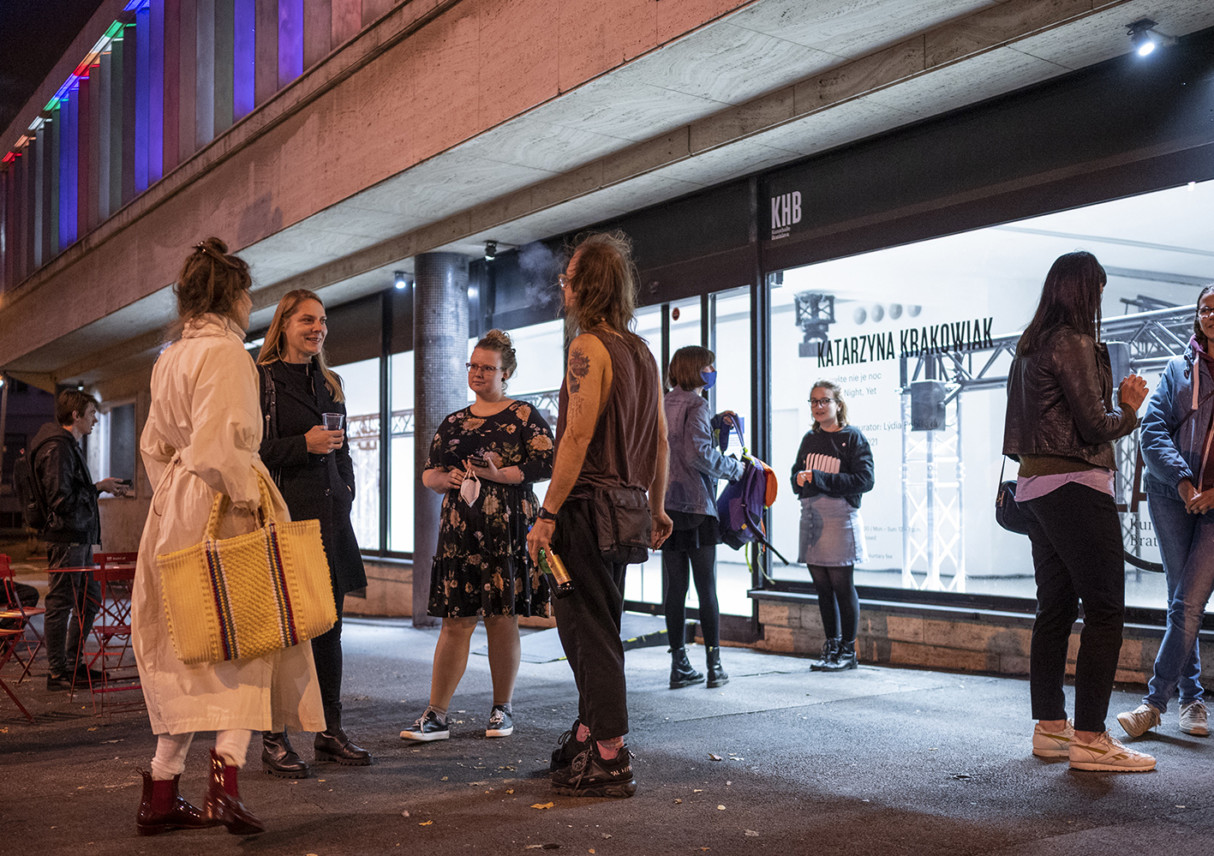It is not night, yet
Through the walls and facades of Kunsthalle Bratislava in SNP Square mass laughter “explodes”. Its source is in thousands of recordings of the laughter of women, men, and all others who support equal rights and freedom. These recordings, to which people from diverse countries have contributed, create one concerted voice that speaks out against injustice, exclusion and oppression. The project follows the mode of work adopted in Krakowiak’s work It Begins With One Word. Choose Your Own (2020) at the Mies van der Rohe Pavilion in Barcelona. Responding to the situation of the pandemic and lockdown, she announced an open call for words that people worldwide wished to make last and take responsibility for. The submitted words combined to form a polyphonic composition, a structure that tied together the architectural and the linguistic. Expanding the meaning of architecture through language, the artist generated a collectively shaped social sculpture.
In Bratislava, Krakowiak has created a monumental sound bridge uniting people in order to let emotions flow freely. As a natural reflex that exists beyond language, laughter accompanies situations where words no longer work. Its atavistic, almost animal force and energy mobilises and unites communities. It is precisely what we need in a time of crisis, when rights are trodden underfoot and freedoms violated. Laughter is a universal human language, which brings positive energy and hope during a long period of depression. The current situation is not by any means easy, just as the laughter resounding from the Kunsthalle Bratislava building is not effortless. Let us overcome anxiety and laugh out loud! Sound is invisible, and so is the power of laughter. It is more persuasive than a thousand words. Katarzyna Krakowiak’s installation broadcasts a powerful message of collective power, mutual support and hope.
When people laugh, they change their perspective on the world and thereby also change the world. Laughter unites. It is almost impossible to keep your distance and uphold the hierarchical rules of the society when laughter makes you gasp for breath. It is a democratising force. The laughing human being drops their mask and steps out of the roles played in ordinary life. By emotions experienced with others, by laughing together, the distance between people is reduced.[1] Laughter touches our emotional core, it changes people’s disposition to a more altruistic one. As we know, laughter has a therapeutic power; it brings relief from pain and lowers stress levels. There is even a laughter yoga, which helps thousands of people to deal with stress and health problems.[2] Gelotology (from the Greek gelos, laughter) is a science that studies laughter and its effects on the body from a psychological and physiological perspective. Its adherents often champion the therapeutic use of laughter in alternative medicine.
For Krakowiak, however, silence is important too. She has worked with it across many projects, for example in the extensive work As If Nothing Could Fall But The Sun (2016), which she has created for architecturally outstanding concert halls in numerous European cities. The structure of the scores heard in it comes from concentration on the phenomena that appear between sounds: silence, pauses and intervals. This is also the case in the work for Kunsthalle Bratislava, where laughter emerges from silence, inconspicuously bubbling up and gradually increasing in loudness. Silence is an effective instrument for following the world in your thoughts. It is the voice of thoughts, redefining and remolding the reality of sound. The acoustic sphere is uniquely woven into the weft of silence.
Krakowiak’s new project, like her previous ones, brims with ambivalence and subversion. No simple reading is offered and there are various levels of interpretation available. The work evokes both positive and negative emotions. It disturbs. On the one hand, the project evokes positive emotions, making a call for communal healing and releasing the flow of joy and cheerfulness via laughter, in order to help us combat the depression that has long troubled us in the pandemic era. On the other hand, the piece addresses a different source of depression: the denial of respect for the fundamental rights of women. At this level, laughter changes to a rebellious mockery.
The French philosopher Henri Bergson emphasised the socio-cultural character of the comic, which in his view is bound up with rigidity, immobility, i.e. whatever is schematic and mechanical. Bergson sees the comic as the rigidity of something that in itself, by its essential nature, is spontaneous and dynamic.[3] Laughter, he says, has a powerful critical and corrective function; it underlines and seeks to repair all that is rigid, all that is the opposite of the flexible, mutable and freely creative life. In this sense, it is a social gesture which rebukes, humbles and shames whatever is insufficiently capable of adapting to social life. Insofar as it attacks social failings, laughter contributes to the healthy running of the society. This is equally the case in our project, where laughter mocks rigidity, conservatism, and sclerotic and unfree thinking. Political power has a justified fear of laughter, because it is capable of overturning values and attitudes, disturbing stability, discrediting anyone and anything, and taking away self-control or the artificially created tension necessary for maintaining discipline. Laughter contains both destructive and constructive forces; it either disturbs a given order or creates a new order.[4]
Laughter is an act of communication. It is a process that facilitates social interaction and connection with others. One laughs best in company, because laughter is infectious and makes it easier to evoke an identical emotional state in others. It also enables the management of conflicts, where one can negotiate, share and contrast existing perspectives. Laughter also has a psychic function connected with self-defence. Via laughter, the human being is capable of lowering the level of fear and anxiety evoked by various external and internal stimuli.[5]
Krakowiak has had a long-term involvement with communication and the potential and limits of language, as well as sounds and the social dimensions of architecture. Working at the interface of conceptual and sensual approaches, she concentrates on a specific problem, an inadequate functioning of something. According to her, all of the actions of human beings are in essence attempts at communication. Architecture is formed by the sounds which are a physical experience of interaction with it. In the architectural context sound, according to Krakowiak, behaves like an object: it falls, rises, expands. When thinking about her new project, we set out from Kunsthalle Bratislava’s central position in the city, in the vicinity of other institutions such as the Polish Institute, a hospital, a market, and the Slovak Republic’s Ministry of Culture. Krakowiak plays a sound game, “sonifies” hidden aerial trajectories, seeks points of relation; laughter here becomes architecture, a bridge. Traditionally, and indeed since prehistoric times, architecture has divided the world acoustically and visually into the exterior and the interior. Krakowiak’s sound gestures disrupt this binary and turn the structures of buildings into membranes / filters, through which spaces can communicate with each other.
Krakowiak is aware of the paradoxes in the functioning of buildings. An exemplary case is the enormous Post Office building in a crowded area in Manhattan, New York, which today is mostly empty due to the major transformation of postal services since the time when it was built. In that setting, she created her project The Great And Secret Show / The Look Out Gallery (2013), where, almost like an archaeologist, she led visitors through the empty rooms and corridors, which she revived with sounds typical of a post office, linking the past and the present. Architecture is erected on sound. It enables sound’s expansion, has the capacity to absorb, filter and transmit sound, reinforces some of its components at the expense of others. Architecture is a mode of organisation of social life. The artist gives it a voice, making buildings speak to us acoustically. She takes their distinctive features as her starting point, revitalising their latent structures, such as the evacuation system.[6] The latter is connected with an alarm, a situation of menace, the need to get out as quickly as possible. In many of her works (including, in a certain sense, her new work created for Kunsthalle Bratislava) she is concerned with such a state of emergency, sounding the alarm.
In the Polish pavilion at the 13th Biennale of Architecture in Venice, Krakowiak presented Making The Walls Quake As If They Were Dilating With The Secret Knowledge Of The Great Powers (2012). She worked with the architecture of the pavilion in order to reinforce and amplify existing sounds: resonating frequencies, the expansion of sound in niches of the interior, the ventilation system, etc. The final work was a trembling, a vibration of the entire building, a live sonification, so to speak. Her focus was on the performative role of a sonic composition, based on the examination of architecture and its divergence from its original function. Listening to architecture via invisible / inaccessible spaces was the starting-point in The Rise And Fall Of Air (2013), a project for the Zachęta – National Gallery of Art in Warsaw. Here the artist was concerned with gravitation in the wider sense, also as a fall, which she thought of as a metaphor for the condition of humanity, with its political consequences. The installation Dust (2018) created in the iconic Halle Berghain in Berlin was a series of acoustic experiences devised by the artist, which resulted in the superimposition of industrial sounds on the hall. In Architecture Is Out Of Tune (2015, Berlin) she addressed architecture’s loss of the capacity to communicate with the contemporary world and its needs. She worked with two melodic lines: birdsong and her own singing. Both voices, however, were incomprehensible, gradually fusing together until they lost their communicative function. Once again, in her sound installation in the glass-fronted space on the ground floor of Kunsthalle Bratislava, Krakowiak returns to birds’ voices and communication breakdown. Here too the birds’ sounds testify to the loss of voice, like the sound of a guitar string tensed to the maximum, which is a clear metaphor for a stalemate situation, whether in the pandemic or in the field of women’s fundamental rights.
Katarzyna Krakowiak was born in 1980, Poland. She lives and works in the town Otwock on Polandand Oliva in Spain. it is not night, yet. In 2012 she gained particular recognition for her work The Walls Quake as if They Were Dilating with the Secret Knowledge of the Great Powers, in the Polish pavilion at the 13th international exhibition of architecture / la Biennale di Venezia. Selected projects: 2020 It Begins with One Word. Choose Your Own, Mies van der Rohe Pavilion, Barcelona; 2018 Dust, Halle am Berghain, Berlin; 2016 As Though Nothing Could Fall Except the Sun, Mieczyslaw Karlowicz´s Philharmonic, Szczecin, from the series Architecture is the Music of Space, Five Exceptional Concert Halls in Europe, instalments in: Blaibach, Reykjavik, Oslo and Porto; 2014 The First Shock of Great Escape, Arsenal, Gdansk; 2013 The Great and the Secret Show/ The Look Out gallery, PERFORMA 13 with Storefront for Art and Architecture, New York City; 2013 Rise and Fall of Air, The Zachęta National Gallery of Art , Warsaw; 2013 When a Steam Breaks the Water Perpendicularly, its Angle is Measured to Be 0 Degree, and the Degree Gets Closer to 90 As It is Slanted More, and the Level Surface is 90 Degrees, Post MoMA, New York City; 2008 – 2011 All. FM, pirate radio stations realised in the cities of Jaffa, Tallin, Mexico City and Wroclaw. Krakowiak leads the Studio of Sound Activities at the Academy of Fine Arts in Warsaw.
[1] Part of the project was the process of collecting recordings of laughter via an open call as well as in cooperation with partner institutions, especially secondary schools and universities and their students.
[2] Kataria, Madan: Joga smiechu [Laughter Yoga] (Bratislava: Ikar, 2020).
[3] Bergson, Henri: Smích [Laughter] Praha: Naše vojsko, 1994, p. 8.
[4] Javorčeková, Romana: “Smiech ako moc a premeny človeka súčasnosti” [Laughter as Power and the Transformations of the Present-day Human Being], Ostium, Vol. 12, 2016, No. 1, online: https://ostium.sk/language/sk/smiech-ako-moc-a-premeny-cloveka-sucasnosti/
[5] https://sk.sainte-anastasie.org/articles/psicologa/la-risa-para-qu-sirvey-cuntos-tipos-de-risa-hay.html
[6] She also addresses the theme of evacuation, escape, in other works, for example in her didactic project in Oxford in which she examined the relationship between the migrant behaviour of animals and humans, as well as in the mentioned projects Dust, and As If Nothing Could Fall But The Sun.
The project is realised with the support of the SPP Foundation, the Adam Mickiewicz Institute, co-financed by the Ministry of Culture, National Heritage and Sport of the Republic of Poland, the Polish Institute in Bratislava and the Academy of Fine Arts in Warsaw, in cooperation with the Bratislava City Gallery, the Academy of Arts in Banská Bystrica, the Josef Vydra School of Arts and the Bohumil Bača Private School of Arts in Bratislava and with the festivals White Night and One World.
The Adam Mickiewicz Institute is a national cultural institution whose mission is to develop and disseminate the cultural dimension of Poland by fostering international collaboration and cultural exchange. Over the last 20 years, the Institute has organised more than 6,000 cultural events with almost 55 million participants. The Institute publishes the Culture.pl web portal with daily updates on the most interesting events related to Polish culture across the world. The Adam Mickiewicz Institute operates under the auspices of the Ministry of Culture, National Heritage and Sport. Co-financed by the Ministry of Culture, National Heritage and Sport of the Republic of Poland.

